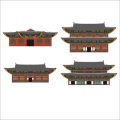Introduction: The Five Elements in British Homes
Step through the threshold of a British home and you’re greeted by more than just bricks and mortar; you’re entering a living tapestry woven from centuries of tradition, evolving weather patterns, and cherished rituals. Here, amidst winding lanes and rolling moors, the ancient philosophy of the Five Elements—Earth, Metal, Water, Wood, and Fire—subtly harmonises with the British interior spirit. Each element is more than a design motif; it is an atmospheric whisper echoing through Georgian townhouses in Bath, seaside cottages in Cornwall, and modern London flats. This gentle guide invites you to discover how these elemental forces shape not only the look but the very soul of British homes—balancing cosiness against grandeur, stillness against bustle, and nature’s unpredictability against handcrafted order. As we journey through each element, you’ll see how they blend seamlessly into Britain’s ever-changing light, its love for layered textures, and its quiet reverence for heritage and hearth.
2. Earth: Grounding Spaces with Heritage and Texture
In the heart of British interior design, the element of Earth plays a foundational role, offering comfort and rootedness that echo centuries of tradition. The presence of stonework—whether in the form of grand hearths, flagstone flooring, or garden walls—immediately conjures images of time-worn manors and countryside cottages. Exposed brick is another beloved feature, its rustic charm bringing warmth and honest character to both urban flats and rural retreats alike.
The UK’s natural palette draws from muted greens, soft greys, ochres, and chalky whites, reminiscent of misty mornings on the moors or sunlit walks through ancient woodlands. These colours wrap spaces in a quiet embrace, grounding inhabitants while fostering a sense of well-being. Earthy textures are not limited to structural elements; woven wool throws, linen curtains, and tactile ceramics all deepen this sensory connection to the land.
| Element | Material | Sensory Effect | British Reference |
|---|---|---|---|
| Earth | Stonework | Cool solidity underfoot, visual weight | Cotswold cottages, stately homes |
| Earth | Exposed Brick | Textural warmth, historical resonance | Victorian terraces, converted warehouses |
| Earth | Natural Palettes | Calmness, subtle continuity with nature | Dorset cliffs, Scottish Highlands |
| Earth | Tactile Fabrics (Wool, Linen) | Comforting touch, layered cosiness | British tweeds, farmhouse textiles |
To invite the Earth element into your home is to pay homage to Britain’s landscapes and heritage. It means crafting spaces where history lingers in every stone and every thread—where the very walls seem to hum with stories of resilience and belonging. In these grounded havens, every detail whispers an invitation: slow down, stay awhile, feel at home.
![]()
3. Metal: Modernity and Vintage Charm Meld
Step into a British home, and you’ll likely find metal quietly weaving its magic through every room—never shouting, but always lending a sense of structure and style. Whether it’s the subtle shimmer of brass taps in a Victorian townhouse or the sharp lines of brushed steel fixtures in a London flat, metal brings together eras, tastes, and stories in a uniquely British way. There’s a particular enchantment to the aged patina on wrought iron banisters that line old Georgian staircases; these elements carry echoes of centuries past while inviting fresh energy into present-day living spaces.
Metal doesn’t just belong to the realm of the ultra-modern. In fact, its true British charm is found in the harmonious blending of vintage details with contemporary sensibility. Picture an Edwardian fireplace framed by intricate cast-iron surrounds, contrasting gently with sleek copper pendant lights above a kitchen island—a balance between nostalgia and innovation. The artful incorporation of metallics, whether through antique door handles or modern chrome radiators, allows rooms to feel both rooted in history and alive to the moment.
This element also symbolises clarity and refinement within the Five Elements philosophy. In British interiors, metals are often chosen for their tactile qualities—cool to the touch, weighty in hand—and their ability to reflect light softly across painted walls or timeworn wooden floors. Even small touches—a pewter candlestick on a sideboard or nickel coat hooks by the entryway—infuse spaces with subtle energy, connecting inhabitants to both earth and sky. Through this quiet interplay of old and new, metal helps British homes tell their ever-evolving stories with grace and authenticity.
4. Water: Invoking Calm in Rain-Laden Lands
Water, a defining force in the British landscape, inspires interiors that gently echo the rhythm of rain and rivers. The nation’s love affair with water is not merely practical but deeply spiritual, shaping both mood and material choices within the home. Soft blues reminiscent of the Thames at dawn, or the mists hovering above a Lake District morning, drape walls and textiles, creating an atmosphere of serenity and poetic reflection.
Sash windows—a hallmark of British architecture—invite the ever-changing sky indoors, often framing droplets trickling down glass on a rainy afternoon. Curved furnishings mirror the gentle undulations of riverbanks and rolling streams, inviting relaxation and a sense of effortless flow into living spaces. Such elements are not only visually pleasing but also foster a meditative calm, making every room a quiet sanctuary from the tempestuous weather outside.
The Spirit of Water in British Interiors
| Element | Design Feature | Emotional Effect |
|---|---|---|
| Soft Blues | Wall paint, cushions, throws | Calm, restful, reflective |
| Gentle Curves | Sofas, armchairs, mirrors | Soothing, inviting flow |
| Sash Windows | Traditional window frames | Connection to nature, openness |
| Water-Inspired Motifs | Ceramics, artwork, patterns | Evokes movement, tranquillity |
The British Experience: Rain as Ritual
In Britain, rain is more than weather—it is ritual. The constant drizzle becomes an ambient soundtrack for daily life, inspiring interiors that cocoon inhabitants in comfort and stillness. Water’s presence is celebrated rather than shunned; from subtle ripple patterns on wallpaper to the placement of vases catching light like dewdrops, each detail is a loving homage to the island’s intimate relationship with water.
5. Wood: Celebrating Nature Through Craft and Coziness
There is a quiet magic in the British approach to wood within the home—a reverence for craftsmanship, heritage, and that ever-present connection to the lush woodland landscapes beyond the doorstep. Tracing the journey of timber beams, rich oak floors, and hand-carved details reveals more than a design choice; it tells a story of tradition woven into daily life. Exposed beams in a centuries-old cottage ceiling recall ancient forests, their gnarled shapes echoing the wild character of English woods. Each plank underfoot whispers of history, as if inviting bare feet to remember the mossy paths of bluebell glades.
Timber Beams: Echoes of Ancestral Woodland
In many British homes, original or reclaimed timber beams serve as both structure and narrative. These beams are cherished not merely for their strength but for their ability to ground interiors with the spirit of ancient trees. It’s as if the woodland has been invited indoors, its silent wisdom cradling every gathering around the hearth. Whether left rugged or lovingly restored, these beams stand as steadfast reminders of Britain’s symbiotic relationship with nature.
Oak Floors: Foundations of Warmth and Welcome
The creak of solid oak beneath one’s step is a quintessentially British sound—comforting and familiar. Oak flooring brings warmth and character, its grain charting the passage of time through each gentle curve and knot. In contemporary settings, pale finishes evoke misty mornings on the moors, while darker stains conjure up visions of stately manors nestled among age-old woodlands. Here, practicality meets poetry as wood offers durability alongside an enduring invitation to linger in comfort.
Hand-Carved Details: Craftsmanship Rooted in Story
No detail is too small when it comes to celebrating wood’s place in British interiors. From intricately carved bannisters to bespoke cabinetry adorned with floral motifs inspired by native hedgerows, artisans infuse personality into every corner. These touches nod to generations of makers who shaped their world with chisel and imagination—imbuing spaces with soul and a sense of belonging.
In blending these elements—timber beams overhead, sturdy oak floors below, and hand-wrought details throughout—British interiors become sanctuaries where woodland spirit meets everyday coziness. The result is an atmosphere that feels timeless yet deeply personal: a quiet celebration of nature’s gifts brought lovingly inside.
6. Fire: Warmth, Hearth, and Heart of the Home
If Earth is the grounding force and Metal lends its quiet strength, then Fire is surely the spirit that animates a British home. Throughout the changing seasons, from grey autumnal afternoons to frost-bitten winter nights, the allure of a glowing hearth has long woven itself into the very fabric of British domestic life.
The Tale of the Fireplace
Step into a traditional country cottage or even a modern townhouse in London, and you’ll often find the fireplace as its soul—the place where stories are told and memories made. The crackle of burning logs or the gentle flicker from a gas fire invites everyone to gather round. It’s not just about warmth; it’s about togetherness. In Britain, the phrase ‘hearth and home’ speaks volumes—it’s shorthand for safety, comfort, and belonging.
Candlelit Evenings: Subtle Magic
Fire’s influence extends beyond the fireplace. There’s a certain enchantment in British interiors when dusk falls and candles are lit—on mantlepieces, dining tables, or windowsills. Their soft glow conjures an ambience both intimate and timeless. Whether it’s a single beeswax taper on a writing desk or clusters of tealights during a festive supper, candlelight is cherished for turning ordinary evenings into something quietly magical.
The Glowing Focal Point
British design instinctively understands the power of a radiant centrepiece. Be it an ornate Victorian grate, a sleek Scandinavian-inspired wood-burner, or simply a collection of lanterns by the patio door, these fiery elements draw people in. Friends gather with mugs of tea after a countryside walk; families huddle close for board games on stormy nights. Fire unites, comforts, and inspires—its warmth both literal and symbolic.
In every season, from bonfire night celebrations to summer evenings spent around a garden chiminea, Fire remains at the heart of British interiors—a reminder that no matter how wild the weather outside, inside there is always light, warmth, and welcome.
7. Conclusion: Harmonising the Elements for Timeless British Style
Embracing the Five Elements—Earth, Metal, Water, Wood, and Fire—within British interiors is less about rigid adherence to tradition, and more about attuning oneself to the gentle rhythms of home life. In a country where history whispers from oak beams and rain patters against sash windows, achieving harmony means blending comfort with a quiet sense of wonder. Picture a Cotswold cottage where cool stone floors (Earth) are warmed by brass candle sconces (Metal), where velvet drapes puddle like rivers at the skirting boards (Water), and sturdy elm tables (Wood) gather friends around a roaring hearth (Fire). The magic lies in subtlety: letting each element breathe without overpowering another, so that rooms feel both rooted and uplifting. For those seeking to infuse their spaces with this uniquely British alchemy, begin by observing how light dances across your mantelpiece or how the scent of fresh herbs mingles with old books. Layer textures thoughtfully—a tartan throw here, a copper kettle there—allowing each addition to tell a story. Remember, true British style is never ostentatious; it’s found in the harmonious interplay between the practical and the poetic. By mindfully balancing these elements, you create a home that not only shelters but also inspires—a place where tradition and imagination coexist effortlessly, offering solace and subtle enchantment with every passing season.


